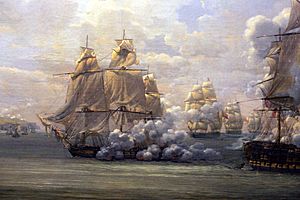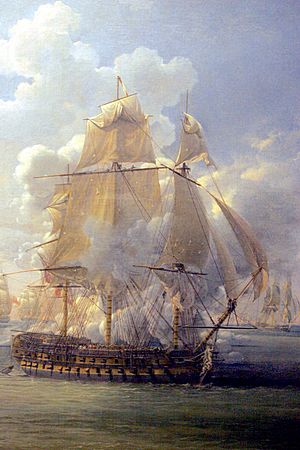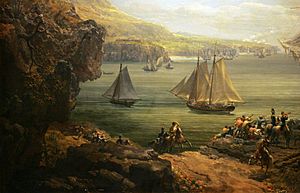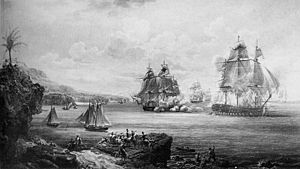Action of 28 June 1803 facts for kids
Quick facts for kids Action of 28 June 1803 |
|||||||
|---|---|---|---|---|---|---|---|
| Part of the Blockade of Saint-Domingue | |||||||
 Detail from the Fight of the Poursuivante against the British ship Hercules, 28 June 1803: Poursuivante delivers her decisive raking broadside. Louis-Philippe Crépin, 1819, Musée national de la Marine |
|||||||
|
|||||||
| Belligerents | |||||||
| Commanders and leaders | |||||||
| Captain Jean-Baptiste Willaumez Commander Jean-Pierre Bargeau |
Captain Henry William Bayntun Captain Charles Brisbane Acting captain John B. Hills |
||||||
| Strength | |||||||
|
1 frigate |
3 74-gun ships of the line | ||||||
| Casualties and losses | |||||||
| 1 corvette captured 10 men killed & 15 wounded |
A few wounded | ||||||
The Action of 28 June 1803 was an important naval battle. It was one of the first fights in the Blockade of Saint-Domingue. This happened after a peace treaty, the Treaty of Amiens, ended. A new war, the War of the Third Coalition, had just started in May 1803.
In this battle, a French warship called a frigate and a smaller ship called a corvette faced three large British warships. The French ships didn't know that war had begun again. The smaller French ship was captured. But the frigate, sailing close to shore, used clever moves. It fired a powerful shot at the British ship. This shot damaged the British ship badly and forced it to stop fighting.
The French captain, Willaumez, was highly praised for escaping a much larger ship. A famous painting was later made to remember this brave event.
Why the Battle Happened
France and Great Britain had been at peace since 1801. This peace allowed France to strengthen its control over its colonies. One important colony was Saint-Domingue (now Haiti). A big uprising, the Haitian Revolution, had been going on there since 1791.
France's leader, Napoleon Bonaparte, sent an army to Saint-Domingue. Their goal was to stop General Toussaint Louverture from making the colony independent. But the peace treaty between France and Britain didn't last. Both sides had problems with it, and tensions grew.
In May 1803, Britain declared war on France. This started the War of the Third Coalition. However, the news of this war had not yet reached the French ships in Saint-Domingue.
On June 27, 1803, the French frigate Poursuivante set sail. It was commanded by Captain Jean-Baptiste Philibert Willaumez. With it was the corvette Mignonne, led by Commander Jean-Pierre Bargeau. They were sailing from Les Cayes to Cap-Haïtien.
Neither ship was fully ready for battle. Poursuivante was supposed to have 40 guns but only had 34. It also had very little ammunition and only 150 crew members. Mignonne was also missing some of its guns and had only 80 men.
Meanwhile, a large British convoy of 50 ships was sailing nearby. Three powerful British warships were protecting it. These were the 74-gun ships HMS Hercule, Cumberland, and Goliath. Early on June 28, 1803, the French and British ships spotted each other.
The Battle Begins
The British ships saw the two French ships near the shore. They sent their warships to investigate. Captain Willaumez quickly realized these were British ships. He didn't know war had started, but he was suspicious. So, he prepared his ships for a fight.
At 8 AM, HMS Hercule came close enough. It raised the British flag. In response, Poursuivante raised the French flag. At the same time, Goliath chased Mignonne. The wind helped Goliath, while Mignonne was stuck in calm waters. Goliath quickly caught up. After a few shots, Mignonne surrendered to the much larger British ship.
At 9 AM, Hercule fired a shot at Poursuivante, starting the main battle. As Hercule moved closer to the shore, the water became shallower. The winds also became tricky. These conditions helped the smaller, more agile French frigate. However, Poursuivante had very little ammunition. Its small crew also struggled to fire the guns and manage the sails at the same time.
Even with limited ammunition, Poursuivante fired carefully. Its shots soon caused serious damage to Hercule's sails and ropes.
A Clever Move
After two hours of fighting, around 11 AM, the wind died down. Both ships almost stopped moving. They now relied on small gusts of wind from the shore. Captain Willaumez saw his chance. He told his gunners to stop firing and help with the sails.
This quick action allowed Poursuivante to move into a perfect position. It could now fire directly at the back of Hercule. Willaumez then ordered a powerful shot. This shot caused great damage and confusion on Hercule. The British ship was so badly hit that it likely feared running aground. It stopped fighting and pulled away.
This allowed Poursuivante to reach the safety of Môle-Saint-Nicolas. People on shore cheered, and the forts fired their cannons in salute.
After the Battle
HMS Hercule's rigging (sails and ropes) was badly damaged. But only a few of its crew were wounded. The ship had to go to Jamaica for repairs. Another British ship replaced Hercule in the squadron.
The captured French ship Mignonne was briefly used by the British Navy. However, it ran aground and was taken out of service in 1804.
Poursuivante had 10 men killed and 15 wounded. Its hull was hit several times, and its rigging was also damaged. Since Cap-Haïtien couldn't repair the frigate, Captain Willaumez had to sail it back to France.
On the way back, a strong gust of wind broke Poursuivante's masts. Willaumez had to stop in Baltimore, USA, for repairs. Once fixed, he left the Chesapeake Bay, avoided the British blockade, and crossed the Atlantic Ocean. He reached Rochefort, France, on May 28, 1804.
There, a British warship tried to stop him. Willaumez fought for 30 minutes before escaping. He found safety at Île-d'Aix. Poursuivante hardly sailed again after this. It became a hulk (an old ship used for storage) in June 1806.
Captain Willaumez was honored for his bravery. He was made a Knight in the Legion of Honour in February and promoted to Officer in June. The Navy Minister congratulated him. A large painting by Louis-Philippe Crépin was commissioned in 1819 to remember this event. It is now displayed at the Musée national de la Marine in Paris.
Images for kids





